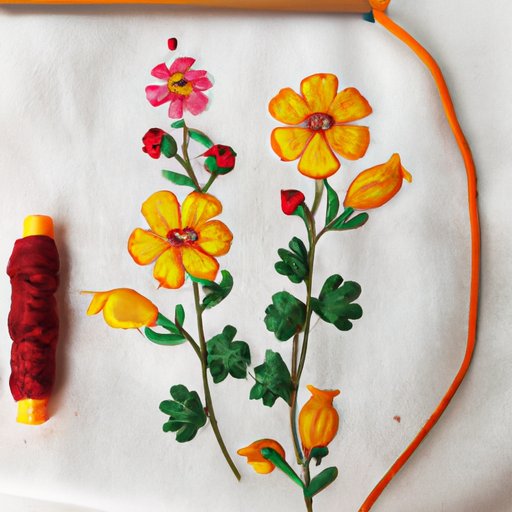I. Introduction
If you’re looking for a new craft or hobby to try, embroidery is a fantastic option. Not only is it an enjoyable and relaxing way to pass the time, but you can also create beautiful, unique pieces that are both functional and decorative.
In this article, we’ll go over the basics of embroidery and how to get started. We’ll cover everything from the necessary equipment, stitch techniques, and how to personalize and customize clothing with embroidery. We’ll also touch on the history of embroidery and how to improve your skills or even venture into embroidering as a business.
II. A Step-by-Step Guide for Beginners
First things first, you’ll need some essential equipment to get started with embroidery. You’ll need an embroidery hoop, embroidery floss (or thread), a needle, fabric (a cotton blend is a great place to start), and a pair of scissors. All of these items can be found at your local craft store, and some stores may even have beginner embroidery kits available for purchase.
Once you have your materials, it’s time to start stitching. The first stitch you’ll want to learn for embroidery is the backstitch. To create a backstitch, bring your threaded needle up through the fabric and then back down through the same hole. Then bring your needle up again a short distance away from the first stitch and repeat the process, looping the needle back through the previous stitch each time. This creates a series of evenly spaced stitches that form a straight line.
Embroidery is a versatile craft that allows you to create intricate designs limited only by your imagination. As you become more comfortable with the basics, you can experiment with more advanced stitch techniques like the stem stitch or satin stitch. Don’t be afraid to try new things and let your creativity run wild.
III. Types of Embroidery Stitches
There are countless types of stitches you can use for embroidery, each with its unique look and style. Some of the most common stitches include the satin stitch, stem stitch, French knot, and chain stitch.
The satin stitch creates a smooth, solid surface by covering an area of fabric with stitches placed close together. The stem stitch is used to create curved lines or shapes, and the French knot adds texture and dimension with small, circular stitches.
It can be a bit daunting to try out new stitches, but with a bit of practice, you’ll quickly get the hang of it. There are plenty of tutorials and instructional videos online to help you learn different stitch techniques. And don’t forget, while it may be frustrating at first, persistence and practice will ultimately pay off with beautiful, intricate designs.
IV. Personalizing and Customizing Clothing with Embroidery
One of the most fun aspects of embroidery is the ability to add a personal touch to everyday items. You can transform plain clothing items into unique statement pieces with a bit of embroidery.
A few creative ideas for personalizing clothing with embroidery include adding a small embroidered design to a plain tee or jean jacket, or incorporating your favorite phrase or quote onto an item. It’s important to choose your embroidery placement carefully to ensure the design is well balanced and doesn’t look cluttered.
When it comes to embroidery designs, take inspiration from the world around you. From florals to animals, geometric shapes, and more, there are endless design possibilities to choose from. And if you’re not sure where to start, there are plenty of pre-made embroidery patterns available online.
V. The History of Embroidery
Embroidery has a rich history, dating back thousands of years across various cultures worldwide. The art of embroidery has been used as a decorative stitch in garments, religious artifacts, and even household items.
In Medieval Europe, embroidery was a highly prestigious craft that represented wealth and status. In China, embroidery was seen as a form of art, with intricate stitching techniques and vibrant colors used to create delicate, detailed designs. And in India, rich embroidery was a traditional part of many wedding and ceremonial garments.
VI. Tips and Tricks for Improving Embroidery Skills
Embroidery is a craft that requires practice and skill to master, but there are some tips and techniques that can help you improve your stitching abilities. One of the best ways to become a better embroiderer is to practice regularly. Start small and work your way up to more complex designs.
When it comes to tricky fabrics, like stretchy knits or silk, it’s important to use the right type of stabilizer to keep the fabric flat and prevent distortion. And always make sure to switch out your needle as needed, as a dull needle can cause fabric to pucker or break.
VII. Turning Embroidery into a Business
Embroidering can be an enjoyable hobby, but it can also be a profitable side hustle or even a full-time business. One of the best ways to start selling your embroidered pieces is by creating an online store on platforms like Etsy or Shopify. Be sure to take high-quality product photos and write detailed descriptions to entice potential buyers.
Social media can also be a useful tool for marketing your embroidery services and pieces. Creating a following on Instagram or Facebook can help you build a customer base and establish yourself as an embroidering expert.
VIII. Conclusion
Embroidery is a beautiful and versatile craft that can be enjoyed by people of all ages and skill levels. By learning some basic stitch techniques and practicing regularly, you can create unique, personalized pieces that are both functional and decorative. So why not give embroidery a try?
If you are new to embroidery, don’t be discouraged if your first few attempts don’t turn out as expected. Keep practicing and experimenting to find your unique style and before you know it, you’ll be creating beautiful embroidered pieces like it’s second nature.
